Things to do in Normandy
Normandy has a lot to offer visitors of all kinds but it is paradise for military-history enthusiasts in particular. Many people come primarily to pay their respects to the Allied dead and tour the battlefields of World War II.
The city of Bayeaux, an ancient Viking settlement, retains its old-world atmosphere with wooden and stone buildings and cobbled streets. The surrounding area is strewn with interesting military history sites, including the famous D-Day landing beaches. In Bayeaux, visitors will also find the magnificent Tapisserie de Bayeux, which tells the story of the famous Battle of Hastings.
To chart the history of two iconic military heroes, travellers should visit the capital of Rouen, where William the Conqueror died and Joan of Arc was burned at the stake. The heart of Richard the Lionheart is entombed in the Chapelle de la Vierge as a token of his love for this city.
The region also has its share of peaceful little towns and beautiful scenery. One of the most popular villages is the picturesque old fishing town of Honfleur, which served as inspiration for some of the famous Impressionist painters. One of them was Monet and his house and garden in quaint Giverny can be explored.
Presiding over the region is the magnificent island monastery of Mont St-Michel. Huge tidal variations mean the island is at times cut off completely by the sea. When the tide retreats, Mont St-Michel is surrounded by a desert of glistening wet sand.
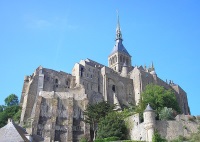
Mont Saint-Michel Abbey
One of France's best-known attractions, the Mont Saint-Michel Abbey, is situated on a rocky island just off the coast of Normandy and Brittany. It was founded in 708 by the Bishop …
Mont Saint-Michel Abbey
One of France's best-known attractions, the Mont Saint-Michel Abbey, is situated on a rocky island just off the coast of Normandy and Brittany. It was founded in 708 by the Bishop of Avranches, who built a chapel here. Construction of the current abbey began in 1023 but was not finished for 400 years. Built with granite, it encompasses a range of architectural styles, from Norman to Gothic. The abbey has been a site for pilgrimages for centuries and has also served as a monastery, a prison and a fortress protecting against the English during its long history.
There is still a Benedictine monastery within the abbey, which can be visited on a guided tour. Among the maze of cobbled streets within the walls of the abbey are a number of other attractions; the little medieval village still boasts its 15th and 16th-century houses and there are shops, restaurants and a few good museums including a maritime museum and a multimedia museum that tells the story of the island. There are also some amazing views out into the bay. Visitors could easily spend a whole day exploring this fascinating place.
Website www.abbaye-mont-saint-michel.fr/en/
D-Day Beaches
Early on 6 June, 1944, the largest armada ever known left England's south coast and set off to liberate France. Shortly thereafter British, American and Canadian soldiers began lan…
D-Day Beaches
Early on 6 June, 1944, the largest armada ever known left England's south coast and set off to liberate France. Shortly thereafter British, American and Canadian soldiers began landing on the Normandy beaches. Today, World War II veterans and their families walk along the same beaches once codenamed Juno, Gold, Sword, Utah and Omaha.
A good place to start a battlefield tour is at Arromanches-les-Bains, a few miles northeast of Bayeux. After it was taken by the British 50th Division, this small fishing village was turned into a mammoth military harbour using a prefabricated port that was towed across the Channel. Two and a half million men and 500,000 vehicles landed here. The wreckage of 'Mulberry Harbour' remains just off the beach.
A little down the coast are Omaha and Utah, the beaches where the US Division famously landed. The cliffs are still pitted with German bunkers and shell holes, but otherwise these fairly innocuous beaches show little sign of the bloody battles that took place on them. Many people come to Normandy to pay their respects to the Allied soldiers at the many vast cemeteries along the coast. The cemeteries are still immaculately maintained, and moving places to visit. Travellers can dig further into the period by visiting the Caen Memorial Museum, the Omaha D-Day Landing Beach and Museum and the Arromanches D-Day Museum, as they're all in the immediate vacinity.
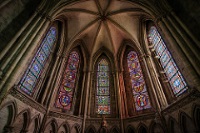
Bayeaux
This ancient Viking settlement is situated a few miles inland, between La Havre and Cherbourg, and was the first French town to be liberated in 1944 during World War II. Fortunatel…
Bayeaux
This ancient Viking settlement is situated a few miles inland, between La Havre and Cherbourg, and was the first French town to be liberated in 1944 during World War II. Fortunately Bayeux was spared from too much war damage, and remains full of old-world character with wooden houses, some elegant stone buildings and cobblestone roads. Many visitors flock here to explore the sites associated with the war's 'Longest Day', including an interesting D-Day museum and the famous landing beaches (less than 10 miles/16km away).
A museum celebrating an older, but equally historic battle is also located in the vicinity: the Musée de la Tapisserie de Bayeux contains the famous tapestry that tells the story of the Battle of Hastings. The 231-foot (69m) strip of embroidered linen depicts scenes of Harold's coronation as the Saxon king of England, him being told of the apparition of a comet (a portent of misfortune), William dressing for war, and Harold's death. Also worth seeing in Bayeux is the Notre-Dame de Bayeux, a fine Norman Romanesque cathedral, rich in sculpture.
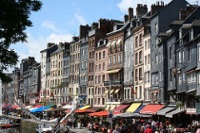
Honfleur
Whether by accident or design, the quaint fishing village of Honfleur, just across the estuary from busy, bustling La Havre, has managed to make time stand still and presents its m…
Honfleur
Whether by accident or design, the quaint fishing village of Honfleur, just across the estuary from busy, bustling La Havre, has managed to make time stand still and presents its many visitors with scenes and experiences largely unchanged for 100 years or more. Honfleur fortunately escaped serious damage during the World War II Normandy landings, and since then development has been minimal. It still functions as a fishing port and follows traditions dating back to medieval times, although it has unfortunately lost its beach due to the silting up of the river.
The town was once very popular with Impressionist painters such as Monet and Boudin because of the changeable light and picturesque coastal scenes; it is still popular with photographers for the same reason. There are a few interesting museums, including those dedicated to composer Eric Satie and Impressionist painter Eugene Boudin, and some lovely gardens. There are also two wonderful churches to visit: the Notre Dame de Grace and Saint Catherine's Church. On Saturdays there is a lively local market selling fresh produce; the local cheese is renowned to be particularly tasty. Honfleur is certainly worth a visit from La Havre and is an attraction in its own right.
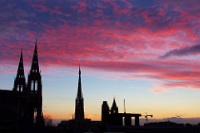
Rouen
The capital of Normandy and a popular holiday destination, Rouen is also a centre of industry and commerce; it is the fifth largest port in France and the closest one to Paris, spl
Rouen
The capital of Normandy and a popular holiday destination, Rouen is also a centre of industry and commerce; it is the fifth largest port in France and the closest one to Paris, split into a right and left bank area by the River Seine.
Rouen is also one of France's most historic cities; William the Conqueror died here in 1087 and in 1431 it was the stage for the trial and execution of Joan of Arc. She was burned at the stake in the Place du Vieux-Marché (the Old Marketplace); the position is still marked by a huge bronze cross and worth visiting while on holiday.
Allied bombing largely destroyed the city of Rouen; all of its bridges and many of its great churches were ruined. However, substantial investment has been focused on restoring parts of the city to its former medieval glory. The great Cathédrale Notre-Dame, immortalised by Monet, remained fairly unscathed and is well worth a visit for its wonderful stonework. An especially interesting Rouen holiday attraction is the Chapelle de la Vierge, where the heart of Richard the Lion-Heart is entombed as a token of his affection for the people of Rouen. The chapel also contains the Renaissance tombs of the cardinals d'Amboise.
Dozens of churches and some fine museums can be explored including the Musée des Beaux-Art, which is one of France's best provincial museums and includes the works of great French artists such as Veronese, Velasquez, Caravaggio, Rubens, Poussin, Fragonard and Monet (including several versions of his Rouen Cathedral).
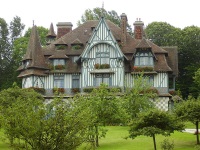
Deauville
Deauville is the only Norman holiday resort to have any delusions of grandeur. It is at the heart of the Norman Riviera that, in the late 19th century, was a particularly popular h
Deauville
Deauville is the only Norman holiday resort to have any delusions of grandeur. It is at the heart of the Norman Riviera that, in the late 19th century, was a particularly popular holiday destination with elite Parisians.
Deauville is still known as the 'lady' of the French coast, and it was a very fashionable lady, in the form of Coco Chanel, who launched both her own career and the quality status of Deauville as a seaside holiday town when she opened a boutique selling her avante garde pill-box and cloche hats to Edwardian ladies bowed under the weight of huge, elaborate millinery creations. Although the town is overrun with tourists and the Edwardian splendour is fading, some of Chanel's elegance survives in Deauville. Nearby Trouville is a smaller and less glamorous version of Deauville, but is also less touristy.
Deauville hosts numerous events, including regattas and polo tournaments, and offers many holiday diversions in the form of casinos, golf courses and exclusive shops. Horse racing is a popular pastime on the town's two courses, and Deauville also boasts a number of restaurants and a spa. There is a strip of beach called the Plage de Deauville that, on warm days, is packed with sunseekers.



